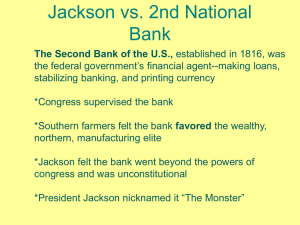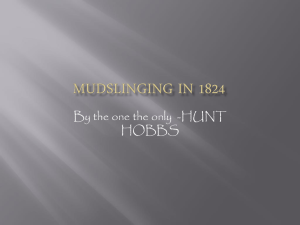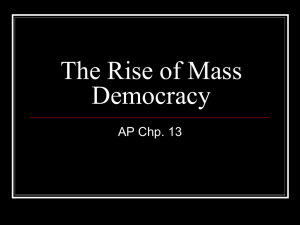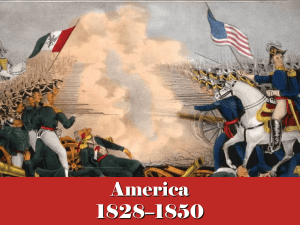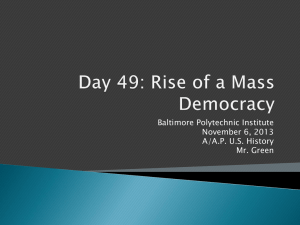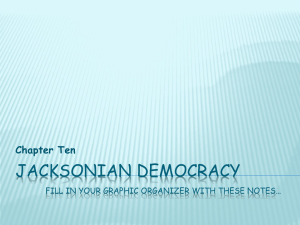Andrew Jackson- 7th US President 1829-1837
advertisement
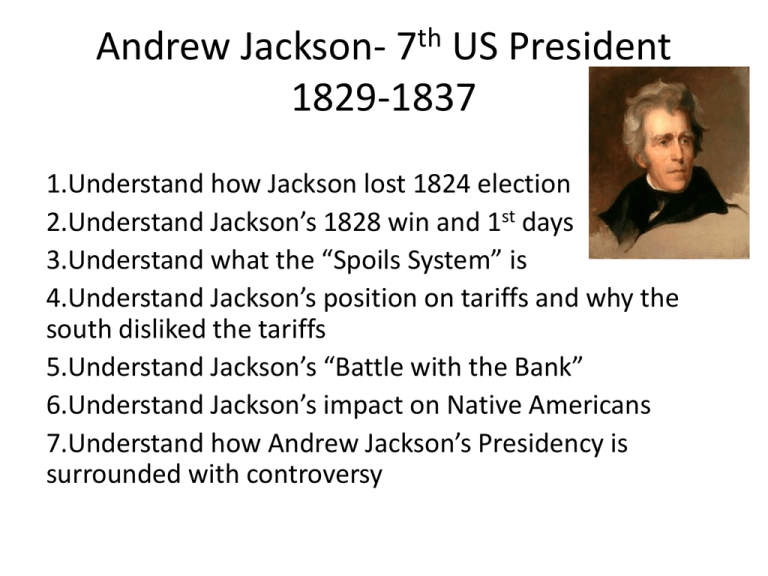
Andrew Jackson- 7th US President 1829-1837 1.Understand how Jackson lost 1824 election 2.Understand Jackson’s 1828 win and 1st days 3.Understand what the “Spoils System” is 4.Understand Jackson’s position on tariffs and why the south disliked the tariffs 5.Understand Jackson’s “Battle with the Bank” 6.Understand Jackson’s impact on Native Americans 7.Understand how Andrew Jackson’s Presidency is surrounded with controversy Station 1 - Corrupt Bargain • John Q. Adams - Secretary of State becomes 1824 US President (6th President) • Henry Clay - Speaker of House of Representatives recommends them to vote Adams in as president. Clay becomes Secretary of State • Andrew Jackson - won popular and electoral vote but not majority • How did this event earn it’s name of the Corrupt Bargain? – Jackson won Popular and Electoral votes but didn’t get a majority. House of Reps. decide who will become 1824 President. Clay recommends Adams, Adams give Clay Sec. of State position. Station 2 - Jackson Finally become President • How many more popular votes did Jackson receive than Adams? How many more electoral votes did Jackson receive in 1828 than in 1824? – 139,222; 79 (99 in 1824 and 178 in 1828) • How would you describe the regions in which Jackson’s strength was the greatest? – The Southwest territory, working class, farmers • From the looks of the 1828 election map, how does it appear that westward expansion might affect national politics? – More people voted and voted Democratic - Jackson Station 3 - The Spoils System • What was the Spoils System? – Rewarding Political supporters with jobs, got advice from friends instead of cabinet members • Why do you think a pig is shown? – Mocking Jackson; a pig is dirty like the Spoil system • What do you see in the background? – White House/Capitol (Washington D.C.) • How is this a good visual representation of the Spoils System? – Jackson took advantage of his victory (to the victor goes the spoils), putting your friends in positions they might not have any idea how to do the position. Station 4 - The Tariff of 1828 • Many of the nation's’ ports were in New England. Why does the chart show strong opposition to the tariff in the north? – Ports are where boats come in and out of, if they are getting goods from northern factories, they don’t need the ports. • How did states in the mid-Atlantic react to the tariff? How can you explain this? – They had lots of factories and wanted US goods to be purchased • Now examine states in the West and the South. They display very strong shifts in beliefs toward the tariffs. What possible explanations can you offer for this? – Protect cotton industry. We need farm equipment from Britain because it is better and cheaper without the tariff Station 5 - The National Bank War • Why was President vetoing the re-charter of the National Bank? – Unconstitutional because it was owned by government • What were Jackson’s personal feelings on the National Bank? – Thought it favored the wealthy and harmed the working class. Government shouldn’t have that much power. Station 6 - Indian Removal • Where was Jackson attempting to move the Native Americans to? – Present day Oklahoma, Trail of Tears - 4,000 of 15,000 died • Examine the political cartoon of Jackson. Who is Jackson holding? – Native Americans • What is the artist implying about Jackson’s attitude toward Native Americans? – Jackson had control “Power” over the Native Americans. Soo….what do you think?? • Was Andrew Jackson a good President? Or a bad President? Why do you think that?


